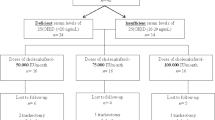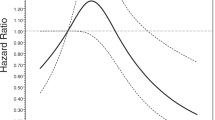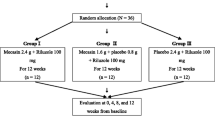Abstract
Amyotrophic lateral sclerosis (ALS) is a fatal neurological disease with motor neuron degeneration. Riluzole is the only available treatment. Two-thirds of ALS patients present with growth hormone (GH) deficiency. The aim of this study is to determine if add-on of GH to riluzole, with an individually regulated dose based on Insulin-like growth factor 1 (IGF-I) production, was able to reduce neuronal loss in the motor cortex, reduce mortality, and improve motor function of ALS patients. Patients with definite/probable ALS, in treatment with riluzole, aged 40–85 years, and with disease duration ≤3 years were enrolled. The study was randomized, placebo controlled, and double blind. Before treatment, patients were tested with a GH releasing hormone (GHRH) + arginine test. The initial dose of GH was 2 IU s.c. every other day, and was progressively increased to a maximum of 8 IU. Primary endpoint was N-acetylaspartate/(creatine + choline) (NAA/Cre + Cho) ratio in motor cortex assessed by magnetic resonance spectroscopy performed at months 0, 6, and 12. Secondary endpoints were mortality and ALS functional rating scale revised (ALSFRS-R). The NAA/(Cre + Cho) ratio decreased in all patients who completed the trial. No significant difference was noted between treated and placebo group. At baseline, although IGF-I levels were within the normal range, 73% of patients had GH deficiency, being severe in half of them. Compared with bulbar onset, spinal-onset patients showed more depressed GH response to the GHRH + arginine stimulation test (10.4 ± 7.0 versus 15.5 ± 8.1 ng/mL; p < 0.05). Insulin resistance [homeostasis model assessment of insulin resistance (HOMA-IR)] increased from 2.1 ± 1.0 at baseline to 4.6 ± 1.9 at 12 months (p < 0.001). Insulin-like growth factor (IGF) binding protein 3 (IGFBP-3) decreased from 8,435 ± 4,477 ng/mL at baseline to 3,250 ± 1,780 ng/mL at 12 months (p < 0.001). The results show that GH exerted no effect on cerebral NAA or clinical progression assessed by ALSFRS-R. Two-thirds of ALS patients had GH deficit, with higher levels in the bulbar-onset group. During follow-up, patients showed progressive increase in HOMA-IR and decrease in IGFBP-3 levels.



Similar content being viewed by others
References
Bensimon G, Lacomblez L, Meininger V (1994) A controlled trial of riluzole in amyotrophic lateral sclerosis ALS/Riluzole Study Group. N Engl J Med 330:585–591
Morselli LL, Bongioanni P, Genovesi M et al (2006) Growth hormone secretion is impaired in amyotrophic lateral sclerosis. Clin Endocrinol (Oxf) 65:385–388
Lai EC, Felice KJ, Festoff BW et al (1997) Effect of recombinant human insulin-like growth factor-I on progression of ALS. A placebo-controlled study. The North America ALS/IGF-I Study Group. Neurology 49:1621–1630
Borasio GD, Robberecht W, Leigh PN et al (1998) A placebo-controlled trial of insulin-like growth factor-I in amyotrophic lateral sclerosis. European ALS/IGF-I Study Group. Neurology 51:583–586
Sorenson EJ, Windbank AJ, Mandrekar JN et al (2008) Subcutaneous IGF-1 is not beneficial in 2-year ALS trial. Neurology 71:1770–1775
Smith RA, Melmed S, Sherman B, Frane J, Munsat TL, Festoff BW (1993) Recombinant growth hormone treatment of amyotrophic lateral sclerosis. Muscle Nerve 16:624–633
Cedarbaum JM, Stambler N, Malta E et al (1999) The ALSFRS-R: a revised ALS functional rating scale that incorporates assessments of respiratory function. BDNF ALS Study Group (Phase III). J Neurol Sci 169:13–21
Suhy J, Miller RG, Rule R et al (2002) Early detection and longitudinal changes in amyotrophic lateral sclerosis by (1)H MRSI. Neurology 58:773–779
Matthews DR, Hosker JP, Rudenski AS et al (1985) Homeostasis model assessment: insulin resistance and beta-cell function from fasting plasma glucose and insulin concentrations in man. Diabetologia 28:412–419
Aberg ND, Lind J, Isgaard J, Georg Kuhn H (2010) Peripheral growth hormone induces cell proliferation in the intect adult rat brain. Growth Horm IGF Res 20:264–269
Kaspar BK, Frost LM, Christian L, Umapathi P, Gage FH (2005) Synergy of Insulin-like growth factor-1 and exercise in amyotrophic lateral sclerosis. Ann Neurol 57:649–655
Kaspar BK, Lladlò J, Sherkat N, Rothstein JD, Gage FH (2003) Retrograde viral delivery of IGF-I prolongs survival in a mouse ALS model. Science 301:839–842
Buckway CK, Guevara-Aguirre J, Pratt KL, Burren CP, Rosenfeld RG (2001) The IGF-I generation test revised: a marker of GH sensitivity. JCEM 86:5176–5183
Pellecchia MT, Pivonello R, Monsurro MR et al (2010) The GH-IGF system in amyotrophic lateral sclerosis: correlations between pituitary GH secretion capacity, insulin-like growth factors and clinical features. Eur J Neurol 17:666–671
Salvatore E, Rinaldi C, Tucci T et al (2011) Growth hormone response to arginine test differentiates between two subgroups of Huntington’s disease patients. J Neurol Neurosurg Psychiatry 82:543–547
Reyes ET, Perurena OH, Festoff BW, Joegensen R, Moore WV (1984) Insulin resistance in amyotrophic lateral sclerosis. J Neurol Sci 63:317–324
Pradat PF, Bruneteau G, Gordon PH et al (2010) Impaired glucose tolerance in patients with amyotrophic lateral sclerosis. Amyotroph Lateral Scler 11:166–171
Torres-Aleman I, Barrios V, Berciano J (1998) The peripheral insulin-like growth factor system in amyotrophic lateral sclerosis. Neurology 50:772–776
Corbo M, Lunetta C, Magni P et al (2010) Free insulin-like growth factor (IGF)-1 and IGF-binding proteins-2 and -3 in serum and cerebrospinal fluid of amyotrophic lateral sclerosis patients. Eur J Neurol 17:398–404
Hosback S, Hardiman O, Nolan CM et al (2007) Circulating insulin-like growth factors and related binding proteins are selectively altered in amyotrophic lateral sclerosis and multiple sclerosis. Growth Horm IGF Res 17:472–479
Olivecrona H, Hilding A, Ekstrom C et al (1999) Acute and short-term effects of growth hormone on insulin-like growth factors and their binding proteins: serum levels and hepatic messenger ribonucleic acid responses in humans. J Clin Endocrinol Metab 84:553–560
Butt AJ, Firth SM, King MA, Baxter RC (2000) Insulin-like growth factor binding protein-3 modulates expression of Bax and Bcl-2 and potentiates p53-independent radiation-induced apoptosis in human breast cancer cells. J Biol Chem 275:39174–39181
Liao L, Dearth RK, Zhou S, Britton OL, Lee AV, Xu J (2006) Liver-specific overexpression of the insulin-like growth factor-I enhances somatic growth and partially prevents the effects of growth hormone deficiency. Endocrinology 147:3877–3888
Niebroj-Dobosz I, Janik P, Soko-Çowska B, Kwiecinski H (2010) Matrix metalloproteinases and their tissue inhibitors in serum and cerebrospinal fluid of patients with amyotrophic lateral sclerosis. Eur J Neurol 17:226–231
Mitsui Y, Mochizuki S, Kodama T et al (2006) ADAM28 is overexpressed in human breast carcinomas: implications for carcinoma cell proliferation through cleavage of insulin-like growthfactorbindingprotein-3. Cancer Res 66:9913–9920
Acknowledgments
This study was supported by grants from Agenzia Italiana del Farmaco (no. FARM53XBKT), Ministero della Salute (progetto ordinario RF-SDN-2007-666932). We thank Merck Serono S.p.A. (Roma, Italy) for donating the study drug and blind packaging.
Conflict of interest
None.
Author information
Authors and Affiliations
Corresponding author
Electronic supplementary material
Below is the link to the electronic supplementary material.
Rights and permissions
About this article
Cite this article
Saccà, F., Quarantelli, M., Rinaldi, C. et al. A randomized controlled clinical trial of growth hormone in amyotrophic lateral sclerosis: clinical, neuroimaging, and hormonal results. J Neurol 259, 132–138 (2012). https://doi.org/10.1007/s00415-011-6146-2
Received:
Accepted:
Published:
Issue Date:
DOI: https://doi.org/10.1007/s00415-011-6146-2




